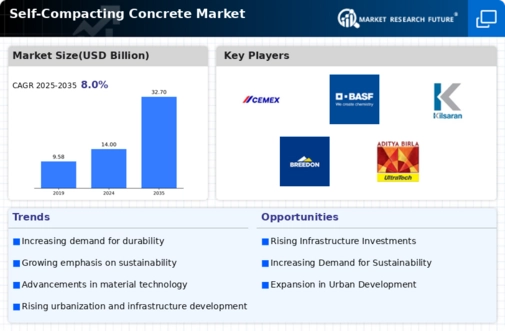Market Trends
Key Emerging Trends in the Self Compacting Concrete Market
SCC is the market that is seen to undergo exceptional trends with the build process in the construction sector being drastically altered. Highly efficient Portland cement concrete (SCC) has found a wide application in construction industry because it flows freely and fills formwork well ensuring that tamping mechanism is not required. Sustainable and ecofriendly construction materials have become a leading market trend due to the extensive rise in the need for them. SCC, nicknamed also for its energy requirements, can certainly be considered to be part of a greener approach to construction, as it causes less harm to our environment when placed.
What is more, R&D projects across the world on improving properties of SCC are growing at an almost stellar rate. SCC's advancements in mix designs, employing by-products, and perfecting particle arrangements are the major influencers in the easing of workability, durability, and strength. This tendency is in tune with the industries' searches for the most welcomed cost-efficient and high-performance products.
In addition, ICTs and smart technologies are slowly but clearly taking the lead in the construction industry and are, in turn, shaping the future prospects of the SCC market. Sensors and other monitoring devices that are placed in concrete construction can be as a source for instant data collection on the material's live performance. This data-driven process not only steers quality control but also propitious for predictive maintenance thus enhances longevity of the structures made out of SCC.
What is more, there is a growing trend for using less-fluid concretes, for a faster hardening of concrete in precast applications. SCC is appropriately referred to as an immensely flowing material, capable of producing complex and heavily reinforced precast elements at the same time, among other things, thereby enhancing productivity and the timelines of construction projects. Clearly, there is a marked increase in the rate of modern architecture in more confined urban locations where rapid construction on minimum space is essential.
Besides market tendencies, there is a spike trend in roads, rail, water systems etc which is greatly influenced by ADSC. The structural superiority and the lowered maintenance necessities of the infrastructure structures made of SCC cement, make it the overwhelmingly preferred choice for bridges, tunnels, and other critical infrastructure. Governments and private sector (stakeholders) are slowly moving away from short term cost recovery and are increasingly focusing on the long term economic benefits of SCC in infrastructure projects, thus fuelling its gradual increase in the market space.
The global construction industry demands for high-performance standards mainly results in inan ecessary situation where the use of self-compacting concrete becomes the only option. Through the emphasis on improving material properties and their sustainability goals, SCC is a major aspect of current construction enactements. In the developing market, partnerships between a research institute, construction companies, and the manufacturer of materials shall be most important for furthering abilities and applications of self compacting concrete.


 Source: Secondary Research, Primary Research, Market Research Future Database, and Analyst Review
Source: Secondary Research, Primary Research, Market Research Future Database, and Analyst Review





Leave a Comment